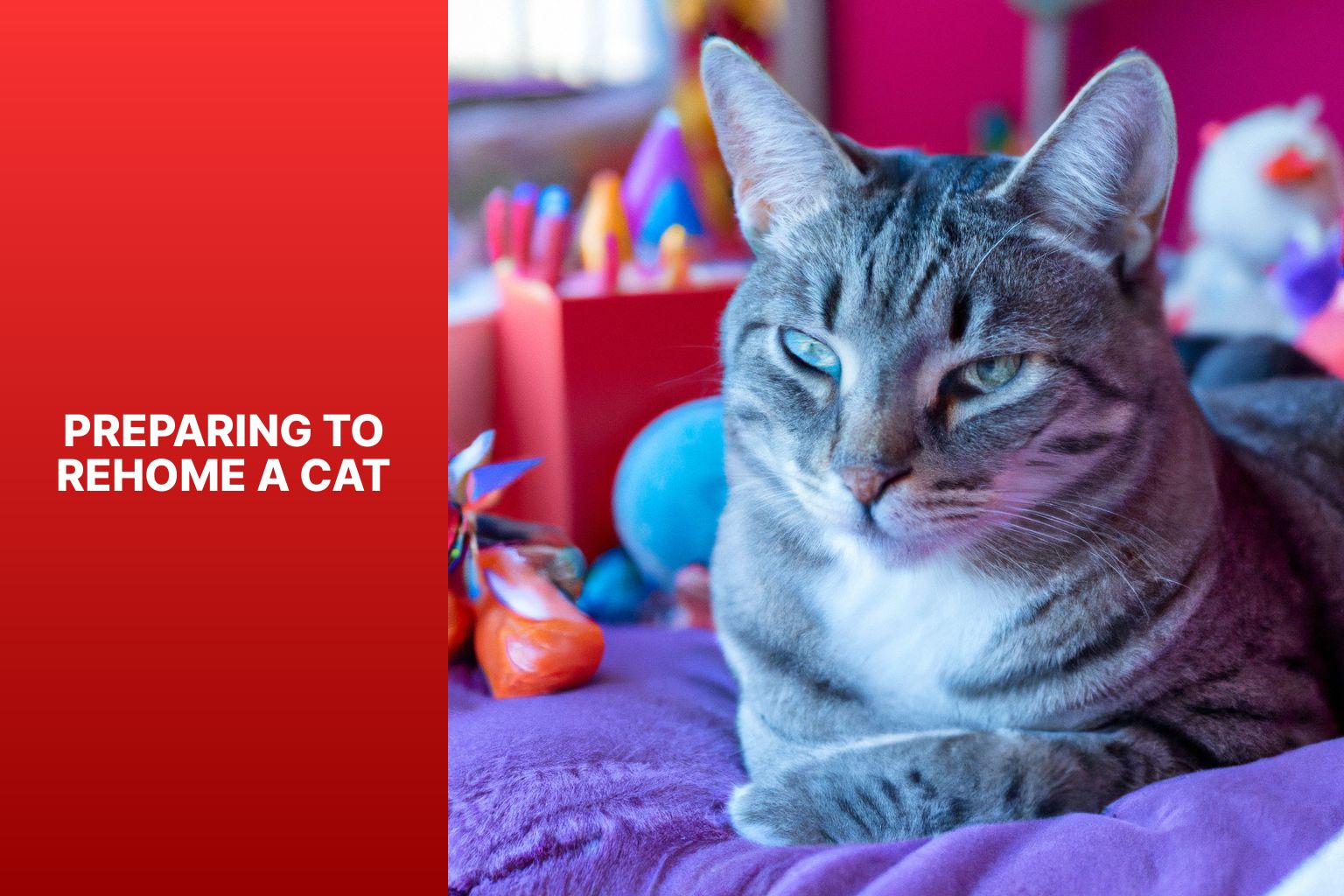Rehoming a cat is a decision that requires careful consideration and planning. Whether you are unable to care for your cat due to personal circumstances or you have found a stray cat in need of a loving home, the rehoming process involves several important steps. This article will guide you through the process of how to rehome a cat, from understanding the reasons why rehoming may be necessary to preparing the cat for a new home and navigating the adoption process.
Key takeaway:
- Rehoming a cat maximizes its chances of finding a loving home: By finding a new home for a cat, you increase its chances of living a happy and fulfilling life with a caring family.
- Rehoming a cat ensures its safety and well-being: If there are reasons that make it difficult for you to continue caring for your cat, rehoming can provide a safer environment and better care for the cat.
- Rehoming a cat requires careful planning and consideration: Before rehoming, it is important to assess your ability to care for the cat, find a suitable new home, and prepare the cat for the transition, ensuring a smooth and successful rehoming process.
Why Rehome a Cat?
Looking to bring a furry friend into your home? Discover why rehoming a cat can be a wonderful choice. Dive into the various reasons that make rehoming a cat a rewarding experience. From providing a loving home to giving a second chance, these insights will shed light on the significance of giving a cat a new start in life. So, let’s explore the compelling reasons behind the decision to rehome a cat.
Reasons to Rehome a Cat
There are many reasons to rehome a cat. If you are unable to provide the necessary care and attention, it is best to find a new home where the cat can receive proper care. Rehoming can also be a solution for allergies or health issues that prevent you from keeping a cat. If there is conflict with other pets causing stress or harm, rehoming can be a responsible choice to ensure the safety and well-being of all animals involved. If you are moving to a location where pets are not allowed or if you are facing financial difficulties, rehoming may be the best decision. Personal circumstances such as a change in work schedule or family situation can also prevent you from giving the cat the attention it deserves, and finding a new home will ensure its happiness and overall quality of life.
Preparing to Rehome a Cat
Photo Credits: Www.Catcornerblog.Com by Raymond Torres
Preparing to rehome a cat? Let’s get you started on the right paw! We’ll cover everything you need to know in this section. From assessing your ability to care for the cat to finding a suitable new home, and preparing the cat for rehoming, we’ve got you covered. So, let’s dive in and ensure a smooth and successful transition for your feline friend!
Assessing Your Ability to Care for the Cat
Assessing your ability to care for a cat is crucial before rehoming. Here are some factors to consider:
1. Time commitment: Cats need daily care and attention. Make sure you have enough time to feed them, play with them, and maintain their litter box.
2. Financial responsibility: Owning a cat comes with expenses such as food, litter, veterinary care, and toys. Consider your budget and ensure you can afford these costs.
3. Living situation: Assess if your living space is suitable for a cat. Do you have enough room for them to move and explore? Is your home safe and cat-proofed?
4. Allergies or sensitivities: Determine if anyone in your household has allergies or sensitivities to cats. Ensure everyone can comfortably live with a cat.
5. Compatibility with existing pets: If you already have pets, consider how they may react to a new cat. Some pets may not get along, so it’s important to assess their compatibility.
Be realistic about your ability to care for a cat. If you can’t meet their needs, consider other options or wait until you can provide the necessary care.
Pro-tip: Before rehoming a cat, research and learn more about cat behavior, health, and general care. This knowledge will help you assess your ability to care for the cat and ensure a smooth transition for them.
Finding a Suitable New Home
When finding a new home for a cat, consider the following factors:
1. Living situation: Ensure the new home is suitable for a cat. Consider the size of the living space, presence of other pets, and outdoor access.
2. Cat compatibility: Assess if the potential owner’s lifestyle and preferences align with the cat’s needs. For example, consider quiet environments or specific dietary needs.
3. Personal experience: Determine if the potential owner has prior experience with cats or other pets. This helps ensure they understand the responsibilities and commitment involved.
4. Financial stability: Confirm the potential owner is financially stable and capable of providing for the cat’s needs, including food, veterinary care, and unexpected expenses.
5. Time and commitment: Consider if the potential owner has the time and commitment to properly care for a cat. Cats require regular feeding, grooming, playtime, and attention.
6.
By considering these factors, you can find a suitable and loving new home for the cat you are rehoming.
Preparing the Cat for Rehoming
Preparing the cat for rehoming involves several important steps. First and foremost, it is crucial to consult a veterinarian to ensure the cat’s good health and keep its vaccinations up-to-date. This will help potential adopters feel confident in the cat’s well-being.
In addition, observing the cat’s behavior is essential to assess its suitability for different households. This way, we can find the perfect home for the cat based on its unique personality traits and special needs.
Proper grooming is also vital. This includes brushing the cat’s fur and trimming its nails, ensuring it looks and feels its best before meeting potential adopters.
Another crucial step is spaying or neutering the cat. This not only prevents unwanted litters but also benefits the cat’s overall health and well-being.
Socializing the cat is key to increasing its comfort around people and other animals. By doing so, we can help the cat adjust quicker and easier to its new home.
To create an engaging adoption ad, it is important to prepare a comprehensive profile that highlights the cat’s attributes. This should include its personality traits and any special needs it may have.
When it comes to advertising, high-quality photographs are a must. These images will showcase the cat’s unique features and help attract potential adopters.
In order to make the cat’s living space comfortable for potential adopters, it is necessary to clean and organize it. By doing so, we create a welcoming environment that reflects the cat’s potential new home.
Gathering all necessary paperwork is crucial. This includes medical records and vaccination certificates, ensuring that the cat’s new owners have all the information they need for its care.
Preparing a supply of food, toys, litter, and other essentials is important for the cat’s smooth transition into its new home. Having these items readily available will help the cat feel more at ease in its new environment.
Considering a trial period for potential adopters is an excellent idea. This allows both the cat and the adopter to ensure compatibility and guarantee a smooth and successful transition.
By following these steps, we can effectively prepare a cat for rehoming and find it a loving forever home.
The Rehoming Process
When it comes to rehoming a cat, it’s important to understand the ins and outs of the process. In this section, we’ll walk you through the steps involved in finding a new home for your furry friend. From creating an adoption profile to organizing meet-and-greets, we’ll cover everything you need to know to ensure a successful and loving transition for your cat. So let’s dive in and make the rehoming process as smooth as possible for both you and your beloved feline companion.
Creating an Adoption Profile
To create an adoption profile for rehoming a cat, follow these steps:
1. Provide a catchy title for the cat.
2. Include clear and high-quality photos of the cat from different angles.
3. Write a detailed description of the cat’s personality, behavior, and unique traits.
4. Mention the cat’s age, gender, breed (if known), and any special needs or medical conditions.
5. Indicate if the cat is spayed/neutered and up to date on vaccinations.
6. Include information about the cat’s compatibility with other animals or children.
7. List the cat’s likes and dislikes, favorite toys or activities, and any training they have received.
8. Provide contact information, including phone number and email, for potential adopters to reach you.
9. Include the adoption fee (if applicable) and any additional requirements or conditions for adoption.
10. End the profile with a heartfelt message, encouraging interested individuals to provide a loving home for the cat.
By creating an informative and appealing adoption profile, you can increase the chances of finding a suitable new home for the cat in need.
Advertising the Cat for Rehoming
When advertising the cat for rehoming, it is important to reach a wide audience and provide detailed information to attract potential adopters. There are several effective ways to advertise the cat:
1. Create an engaging adoption profile that incorporates high-quality photos, a captivating description highlighting the cat’s personality and unique traits, and any special requirements.
2. Utilize online platforms such as social media, adoption websites, and local community forums to share the adoption profile. Make sure to update it regularly to keep the listing active.
3. Seek assistance from local animal shelters, rescue organizations, and veterinary clinics to promote the cat through their networks.
4. Place flyers or posters in pet-related businesses like pet stores, groomers, and veterinary clinics. Don’t forget to include tear-off contact information for interested individuals.
5. Network with friends, family, and colleagues to spread the word about the cat’s need for a new home. Word-of-mouth can be highly effective in finding potential adopters.
It is essential to be honest and transparent when advertising the cat for rehoming. Provide accurate information about the cat’s behavior, medical history, and any special needs. By effectively advertising, you can increase the chances of finding a suitable and loving home for the cat.
Did you know that 87% of pet owners found their pets through online adoption listings?
Screening Potential Adopters
When screening potential adopters for a rehomed cat, it is crucial to prioritize the cat’s well-being and compatibility with the new owner. In order to do so, you must consider the following factors:
First, you should evaluate the potential adopter’s previous experience with cats to assess their knowledge and ability to provide proper care. Second, it is important to assess the potential adopter’s lifestyle, living situation, work schedule, and presence of other pets to ensure a suitable environment for the cat. In addition, you need to verify the potential adopter’s financial capability to meet the cat’s needs, including food, veterinary care, and supplies.
Furthermore, it is essential to determine the potential adopter’s level of commitment and responsibility towards long-term cat care, such as regular veterinary check-ups and vaccinations. Lastly, make sure that the potential adopter’s lifestyle and preferences align with the cat’s specific needs and temperament.
By carefully considering these factors when screening potential adopters, you can ensure that the rehomed cat finds a loving and suitable forever home.
Arranging Meet-and-Greets
Arranging meet-and-greets is crucial for finding the right match between a cat and potential adopters. It is important to follow a step-by-step process to ensure the best outcome.
1. Begin by creating a list of screened potential adopters. This will help you narrow down the candidates and focus on those who are most likely to provide a suitable home for the cat.
2. Once you have the list, schedule meet-and-greets with each potential adopter. This will give them an opportunity to interact with the cat and see if there is a connection.
3. Prepare a comfortable and safe space for the cat and adopter to interact. This could be a designated room or area where they can get to know each other without any distractions.
4. Introduce the cat to the adopter and provide them with information about the cat’s personality, history, and needs. This will help the adopter understand what they can expect and if they are capable of meeting the cat’s requirements.
5. During the meet-and-greet, allow the adopter to bond with the cat and observe their compatibility. This will give both parties a chance to see if they are a good match.
6. It is also important to facilitate a conversation between the adopter and the cat’s current caregivers. This will address any concerns or questions that the adopter may have.
7. During the meet-and-greet, assess the adopter’s interest, commitment, and ability to provide a suitable home for the cat. This will help you determine if they are truly invested in giving the cat a loving and responsible forever home.
8. Consider organizing multiple meet-and-greets to ensure the best match. This will give the cat and potential adopters more opportunities to gauge their compatibility.
9. After the meet-and-greets, gather feedback from the adopters and caregivers. This will help you evaluate the experience and make an informed decision about the most suitable adopter for the cat’s well-being.
10. Remember, the purpose of meet-and-greets is to allow the cat and potential adopters to assess compatibility and ensure a loving and responsible forever home. By carefully arranging these meetings and following the steps mentioned above, you can increase the chances of finding the perfect match.
Finalizing the Adoption
To successfully finalize the adoption of a cat, it is important to follow these steps:
1. Thoroughly review the adopter’s application and references to ensure their suitability in providing a loving and responsible home.
2. Conduct a comprehensive home visit to assess the living environment and confirm its safety and suitability for the cat.
3. Schedule a meet-and-greet session between the adopter and the cat, during which their interaction can be observed to ensure compatibility.
4. Discuss all adoption details, including fees, vaccination records, and the requirements for spaying/neutering.
5. Provide the adopter with a detailed adoption contract that outlines all terms and conditions.
6. Collect the adoption fee, if applicable, as this will support our organization’s ongoing efforts in caring for other cats in need.
7. Coordinate a date and time for the final handover of the cat to the adoptive family.
8. Gather all of the cat’s belongings and medical records to prepare them for the transition.
9. During the handover, take the time to educate the new owner about the specific needs of the cat.
10. Ensure that the adopter has access to contact information for post-adoption support or assistance.
To truly appreciate the importance of finalizing the adoption, let us share a heartwarming story involving a special cat named Whiskers. After going through a meticulous screening process, a loving family was chosen as the perfect match for Whiskers. The meet-and-greet session went exceptionally well, and it was clear that the family was dedicated to providing a safe and comfortable home. The adoption contract was carefully reviewed and signed, and the necessary fee was paid. With great excitement, the new owner took Whiskers home, where they continued to shower him with love and care. Whiskers thrived in his new environment, and the family regularly reached out for support, which was readily provided. This successful bond between Whiskers and his new family was made possible by the thorough process of finalizing the adoption.
After Rehoming the Cat
After successfully rehoming a cat, the journey doesn’t end there! This section will guide you through what happens after the cat finds its new home. We’ll explore how to follow up with the new owner, ensure the cat’s smooth adjustment to its new surroundings, and provide ongoing support to both the feline companion and the new owner. Get ready to make the transition as seamless and positive as possible for everyone involved!
Following Up with the New Owner
Following up with the new owner is crucial after rehoming a cat. It ensures that the cat is settling well and that the owner has the necessary support.
One way to follow up is by scheduling a post-adoption visit. This allows you to observe how the cat is adjusting and address any concerns. It’s recommended to schedule this visit within the first few weeks.
Another way to follow up is by maintaining open communication with the owner. This can be done through phone calls, emails, or social media. Regular check-ins help address any issues and provide guidance on feeding, grooming, and behavior.
Offering ongoing support is important. This includes providing cat care resources, recommending local vets, and offering training and socialization guidance.
Following up ensures the well-being and happiness of the rehomed cat, while also showing that you care and are available to assist when needed.
Suggestions:
- Provide a hotline or helpline for emergencies or immediate concerns.
- Offer a comprehensive guide on cat care, covering feeding, grooming, and health.
- Organize regular adoption reunions for new owners to connect and seek advice.
- Implement a long-term follow-up system to monitor the cat’s progress and provide ongoing support throughout its lifetime.
Helping the Cat Adjust to Its New Home
Helping the cat adjust to its new home: Give the cat space and time. Set up a quiet area in the new home where the cat can feel safe and have privacy. Allow the cat to explore and adjust at its own pace.
Establish a routine: Cats thrive on routine, so create a consistent schedule for feeding, playtime, and cleaning the litter box. This will help the cat feel secure and settled in its new environment.
Provide familiar scents: Place familiar items from the cat’s previous home, such as bedding or toys, in its new space. These scents can help the cat feel more comfortable and reduce anxiety.
Introduce other pets gradually: If there are other pets in the household, introduce them to the new cat slowly. Start by allowing them to sniff each other under a door or using a barrier to create separate spaces initially.
Offer hiding spots and vertical space: Cats feel safe when they have places to hide or perch up high. Provide hiding spots like cat trees or cardboard boxes, as well as vertical spaces like shelves or window perches.
It’s important to monitor the cat’s behavior and provide reassurance and gentle encouragement during the adjustment period. Remember, each cat is unique, and it may take time for them to adapt to their new surroundings. Patience and understanding are key in helping the cat adjust to its new home.
Providing Support to the New Owner
Providing support to the new owner is crucial for a successful cat rehoming process. Ways to offer support include:
- Offer guidance: Give information about the cat’s routine, including feeding, grooming, and playtime. Provide advice on handling common behavioral issues.
- Answer questions: Be available to address any questions or concerns the new owner may have, such as litter box training, introducing the cat to other pets, and dealing with separation anxiety.
- Provide resources: Share recommended veterinarians, pet supply stores, and local cat adoption groups to help with necessary supplies and services.
- Follow up: Check in with the new owner after adoption to see how the cat is settling in. Offer support and assistance if needed, and address any further questions they may have.
In a heartwarming example, a small town cat rescue organization offered free training sessions to new adopters. These sessions covered basic cat care, understanding cat behavior, and solving common cat-related problems. The organization also provided a hotline for adopters to seek advice or assistance. By offering this support, the organization ensured that both the cats and their new owners could thrive and build a loving and lasting bond.
Some Facts About How To Rehome a Cat:
- ✅ Rehoming a cat can be a difficult decision and a stressful process. (Source: Our Team)
- ✅ It’s important to try to address any behavioral issues or medical problems before considering rehoming. (Source: Our Team)
- ✅ Giving the cat to a friend or family member is the best option, followed by a reputable rescue organization. (Source: Our Team)
- ✅ Surrendering the cat to a shelter or giving it to a stranger are less ideal options due to the high number of animals in shelters. (Source: Our Team)
- ✅ Listing the cat on sites like Craigslist can be risky, as it’s hard to ensure a good home. (Source: Our Team)






